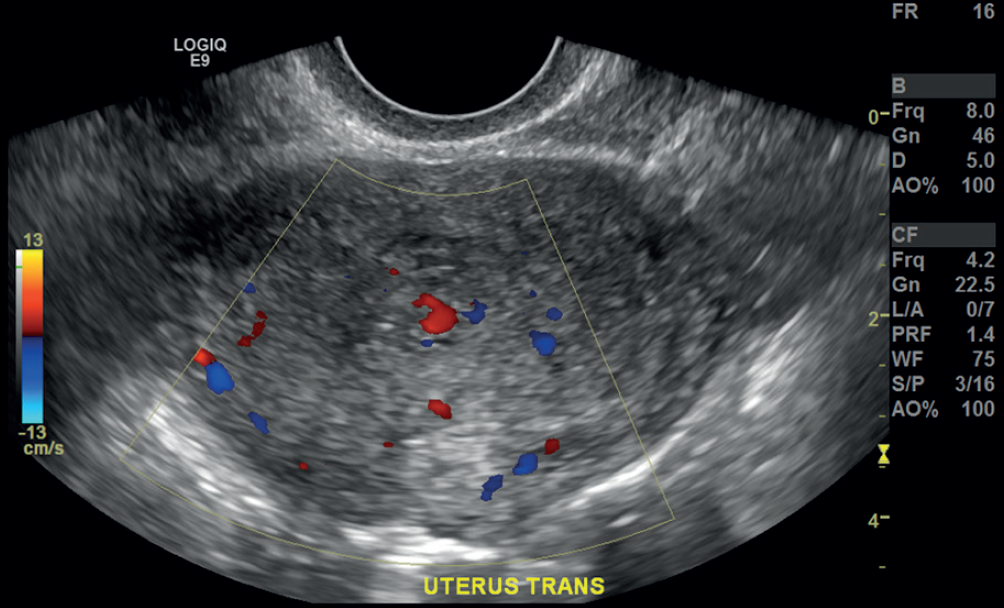Background
Uterine curettage after spontaneous pregnancy loss may result in complications. Common complications include infection, formation of adhesions, bleeding, or perforation [1,2]. A less common complication is development of uterine arteriovenous fistula (AVF). Many patients with AVF will spontaneously settle with conservative management, however, persisting symptoms require more definitive treatment, traditionally with hysterectomy [3].
The presenting symptom is per vaginal bleeding which may be heavy menstrual or intermittent, occasionally associated with discharge in the setting of superimposed infection [4]. Ultrasound is the first line recommendation as this can diagnose the vascular lesion and exclude alternative diagnosis, like endometritis.
This report shows a case of post-instrumentation AVF with pseudoaneurysm, in which trans-arterial embolization as a single and definitive procedure resulted in an efficacious uterine-sparing outcome.
Case Presentation
A 34-year-old female, G5 P1, presented to her rural emergency department with recurrent large volume per-vaginal bleeding having recently undergone curettage following spontaneous early pregnancy loss at approximately 8 weeks gestation. She was not anemic and her abdomen was soft and non-tender. Transvaginal ultrasound showed large vessels in the bulky posterior uterine body and fundus, with pulsatile monophasic waveform and a large pseudoaneurysm (Figure 1a and b). After gynecologic assessment, she was started on tranexamic acid 1 g Ter die sumendum (TDS) (Pfizer) for 3 months. Unfortunately, her symptoms did not improve and she was offered hysterectomy. Given her desire to preserve her uterus, possibility of future fertility, and preference away from surgery, she was referred for endovascular assessment.
After travelling to a metropolitan center and assessment at an interventional radiology clinic, angiography was arranged with a day-admission bed for the following day. The right common femoral artery was accessed and 5-French sheath inserted (Terumo, Japan). A 5-French angiographic catheter (C2 glidecath, Terumo, Japan) was taken to the left then right uterine artery. Figure 2 shows the left uterine arteriogram with hypertrophic vessels particularly to the left of the fundus, with early venous filling (AVF), and a large pseudoaneurysm. The fistula and pseudoaneurysm were supplied from both uterine arteries. A slurry of gelfoam (gelatin sponge) was made by mixing 2 macerated gelfoam sheets (Pfizer) with 5 ml 0.9% saline and 5 ml contrast (Omnipaque 300, Iohexol, GE health-care) through a 3-way tap. A total of 5 ml was injected via each uterine artery and subsequent angiography showed occlusion of both the fistula and pseudoaneurysm. The patient ambulated 2 hours after the procedure and was suitable for discharge. Ultrasound at 3 months after the embolization demonstrated reduced uterine bulkiness and marked reduction in the vascularity of the uterine fundus with no residual fistula or pseudoaneurysm (Figure 3). At 2 years follow-up, she had no further clinically significant episodes of dysfunctional bleeding and with normal menses throughout this time. She is no longer actively seeking pregnancy.
Discussion
Failed early pregnancy places a significant physical and psychological burden on the expectant woman [5]. To add to this, in approximately 1% of cases, retained products may be seen and may present as fever, pain, and/or per-vaginal bleeding [1]. Persisting symptoms require treatment often with dilatation and curettage, and immediate risks include perforation or hemorrhage (5%) while delayed complications include AVF with or without pseudoaneurysm (<1%) and intra-uterine adhesions (5%–10%) [2]. Many patients with AVF will spontaneously settle with conservative treatment including antibiotics (if concomitant infection) and tranexamic acid [3]. It is rare that symptoms persist and it presents a challenge for decision making in that circumstance.

Transvaginal ultrasound in axial plane shows markedly reduced vascularity and thrombosis of the pseudoaneurysm, correlating with cessation of abnormal uterine bleeding.
Hysterectomy is the traditional treatment in this circumstance and is widely available even in a regional or rural town. It was offered to the patient in this case, however, presents a conundrum considering the patient recently underwent a failed pregnancy, the prospect of absolute loss of fertility may cause further psychosocial harm in some patients [6]. In addition, this major surgery carries risks, requires a long recovery, and at significant cost [7]. In contrast, embolization offers a day-procedure alternative with fewer major complications and faster recovery than for surgery [8]. Embolization may be used as an adjunct to hysterectomy however there are only a few cases in literature of this rare condition where treatment with embolization was the single and definitive treatment used [3,4]. There are also reports of successful pregnancy after embolization for uterine AVF [4]. There is insufficient evidence to form a consensus on the type of embolic to use in this circumstance; however, the use of gelfoam, a temporary embolic which is also cheap, allows for a non-permanent embolization and with a very low risk of uterine infarction [9]. Future pregnancy outcomes after this treatment remain unknown. However, uterine preservation at least provides this as an option compared with hysterectomy.
In this case, a safe and efficacious treatment was adopted which was able to preserve the patient’s uterus and highlights the advantage of a multidisciplinary approach to complex healthcare even for patients in a regional or remote location.
What is new?
Uterine AVF is a rare complication of uterine curettage. Traditionally, this is treated with hysterectomy. Many women, however, seek an alternative to preserve their uterus and potential future fertility. In this case report, transarterial embolization of the AVF was performed which offered a day-case procedure with quick recovery, and definitive treatment for this patient. This type of treatment may be offered more widely in the future.



